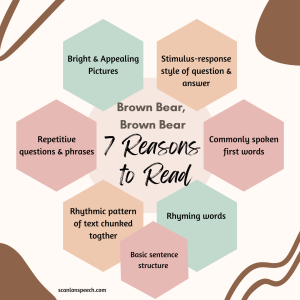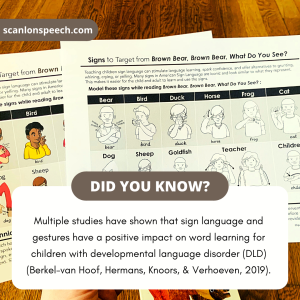Sign Up For Our E-Blast To Receive Information on our Books, Speech Therapy materials and our latest freebies!
How to Read “Brown Bear Brown Bear, What do you See?” to Get your Toddler Talking

Brown Bear, Brown Bear, What Do You See? written by Bill Martin and illustrated by Eric Carle is a classic children’s book. It’s predictable, rhythmic, and colorful.
It doesn’t tell a story or move us emotionally, yet most toddlers and young children love it. They want to speak it, sing it, and then read it again!
Why is Brown Bear, Brown Bear, What Do You See? so wildly popular in early education and with young children?
Here are 7 reasons why so many speech language pathologists and educators have used since it was first published in 1967:
- The pictures are bright and appealing but simple and not over-stimulating.
- The question, “What do you see?” and the phrase, “I see a…” repeat throughout the book. This stimulus-response style tenderly elicits a response from your child.
- The repetitive questions and phrases provide your child ample opportunities to “read along” or say the words because he or she can remember the lines and anticipate what will come next.
- Commonly spoken first words (e.g. see, bear, dog, cat, horse) compose most of the text. Therefore, the words are developmentally appropriate making it easier for your child to understand, retain, and try to say the word (Scanlon, 2019, p.29).
- The rhythmic pattern of the text emphasizes chunks of words together enabling your child to chant word combinations like “brown bear”, “white dog”, “black sheep”, etc.
- The words “see” and “me” not only repeat but also rhyme. Rhyming increases awareness of sounds and enhances recall.
- Basic sentence structure is modeled throughout the book in the form of a question, “What do you see?” followed by a grammatically correct response, “I see a red bird looking at me.” This promotes sentence formulation and comprehension.

Now that we understand why Brown Bear, Brown Bear, What Do You See? is such a wonderful book allow me to share some helpful ways to read it to effectively elicit speech and language from late talkers or language delayed children.
1. Sing the book
Don’t just read it, sing it! (Similar to Raffi’s book Baby Beluga) This book has a great melody that’s best experienced when singing the verses. The rhythm and melody of poems helped him learn how to read. Check out this video of Bill Martin “reading” this book:
Did you know that Bill Martin, Jr. the author didn’t learn to read until he was in college?
3. Chunk it.
Children tend to learn words in chunks (all gone, all done, once upon a time) and may not fully process or understand each individual word until a later point. For instance, they know that “all gone” means that there’s nothing left, but they may not know the individual meaning of all, as in give me all the blocks. They are not yet processing each word individually. For early learners, try to preserve the chunks together (e.g. What do you see? I see a _______ looking at me). This will be effective in helping toddlers remember and recall the phrases. Bill Martin knew this and purposefully chunked words together.
4. Incorporate gestures and sign language
- Point to your eyes or your child’s eyes when singing the words “see”.
- Point to the animal in the book you are reading about. For instance when reading about the brown bear (point), brown bear (point) in unison with singing each word (this makes it interactive). It also directs the child to the pictures in the book.
- When singing “What do you see?” Shrug your shoulders as if asking a question.
- Learn the signs for the animals featured in the book (e.g. bear, bird, duck, horse, etc) and model them while reading the book. This is because sign language can stimulate language learning, spark confidence, and offer alternatives to grunting, whining, crying, or yelling. Many signs in American Sign Language are iconic and look similar to what they represent. This makes it easier for the child and adult to learn and use the signs.
- Sign AND Say the word. Research has shown that using sign language. Research has shown that using sign language in combination with spoken language is a more effective intervention that using spoken words alone (Wright et al., 2013). Therefore, say the word verbally as you model the sign. Before modeling the sign, ensure you have your child’s attention as children learn best when fully engaged. Additionally, provide the sign in context. Sign and say, “bear” when you child is looking at or pointing to the picture of the bear.

5. Quick – turn the page!
After singing or chanting the question, “What do you see?” I prefer to simultaneously turn the page to the next animal so the child can see the animal that is being mentioned.
6. Pause and wait expectantly
Pause and give the child a chance to say something.
7. No Tester Questions
Avoid asking what I call Tester questions like “What’s this?” or “What’s that?” as they stifle the communicative exchange and flow of the book.
Other tips:
For younger toddlers (12 to 15 months give or take a month or two), start with having them make the respective animal sounds.
- Enhance Your Speech Therapy Sessions with ‘Picky Kitty’ – A Must-Have Game for Every Speech Therapist
- Same and Different: Why Speech Therapists and Educators Should Target this Basic Concept
- New Beginnings for Scanlon Speech Therapy
- Articulation Speech Therapy: Favorite Activities, Games, and Books to Target the TH Sounds
- Articulation Speech Therapy: Favorite Activities, Games and Books to Target the L Sound



